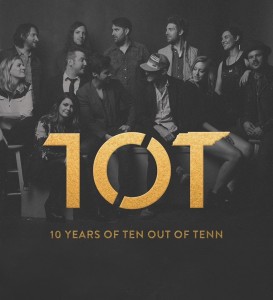
“The first writing session that we had was the easiest and most comfortable co-write you could ask for,” Trent Dabbs told me on a warm day in February in Nashville sitting inside his publicist’s office on Music Row. He, of course, was talking about his Sugar & the Hi-Lows bandmate Amy Stroup.
Dabbs, a well-known solo artist and producer, formed Sugar and the Hi-Lows with Stroup in 2012 after several productive co-writes where he recalls the songs were practically writing themselves.
“The more that Amy and I would write, the more inspired we felt, the more the songs were taking shape and getting better,” he adds. “I personally never felt like we plateaued as writers. We were only gaining momentum.”
Meanwhile, Stroup remembers her first co-write with Dabbs as being one of her favorite co-writes ever. One of the songs they wrote, “This Can’t Be the Last Time” appeared on their self-titled debut in 2012 after both artists decided it was time to start a band together.
While they’ve been together for a few years now, Sugar & the Hi-Lows’s sophomore album High Roller marks a new journey. The duo have further cemented their reputation as a must-see live act and dates opening for Kacey Musgraves continue to get their music out to a much bigger audience. The title track they wrote with Barry Dean, who Dabbs previously wrote Ingrid Michaelson’s “Girls Chase Boys” with, which also happened to be the first co-write for the duo.
“When he wrote with us, I could just feel that he was bringing out any shamelessness or quirks or anything that we had that we were hesitant to bring,” Dabbs admits. “I think that’s what makes a cool writer. We wanted to do a song that’s a straight up dance move that you can’t help but move around to. We played it at the Grand Ole Opry and no one was in their seat. There were people in the aisles. I felt like I was in The Blues Brothers.”
Stroup is quick to add that while writing “High Roller” she wanted to create a specific dance for the song inspired by her bandmates’ fancy footwork which is often highlighted at their live shows.
“I remember thinking, there are dances in the ‘60s, there are all these titles of songs, the shimmy and some of the ones we use in the second verse that we call out. ‘The Macarena’ was a huge song in the ‘90s. We were like, ‘Let’s try a modern day one that fits Sugar and the Hi-Lows.’”
So what exactly does that dance look like? The band show off some of their moves in the music video for the song above.
Highlights on the album include “Bees Love the Trees,” a title that Dabbs says was all Stroup’s idea. “I don’t know where in the world it came from,” he laughs, adding that it was a certain feeling they were chasing in their co-write.
“We were playfully calling out Music Row,” Stroup admits. “If you think about Johnny Cash style, if you remember, he released the Billboard article flicking off Music Row. There’s this badass sentiment, ‘We don’t need Music Row. Let’s be ourselves and see what happens,’” she says of the song.
While Stroup admits that they’re not flicking off Music Row per say, the song instead gives a nod to the rebels and artists who have forged their own path like Elvis Presley, Emmylou Harris, Jack White and Johnny Cash.
“There’s still something to offer when people seemingly don’t have all the attention of the corporate world looking on them. There’s still room for greatness coming out of these people time and time again,” she adds.
The album also includes “I Don’t Get High,” a song Dabbs says was an original way to tackle a love song, as well as “Right Time to Tell You” which is based around indecision. “If you listen to it, it feels like it has no finality but in the very last line it does,” Dabbs says. “It is about not wanting someone to leave, not letting them go. It’s a conversation I got from others.”
While Stroup admits that it’s scary to be so honest in co-writes, she says that writing with Dabbs allows her to say what she’s really feeling.
“There is some form of overcoming that, ‘Alright, this is how I feel and I’m just going to say it.’ Those are the songs that get me. I hope we can do that.”
Having frequently been compared to Carla Thomas and Otis Redding, it is this compliment that the duo don’t take lightly. In fact, Dabbs grew up listening to these classic singers and credits Redding and his father for influencing the band’s music.
“Listening to the classics like we did growing up and having a father say music isn’t good unless you can dance to it, helped us try to write songs that were more upbeat,” Dabbs said.
As for the comparisons to Redding and Thomas?
“You realize that you’re a ripple on a wave in an ocean and you’re just lucky to be in the ocean. I am thankful to be in the ocean and have influence on anyone,” he concludes.
Sugar & the Hi-Lows sophomore album High Roller is available now.
